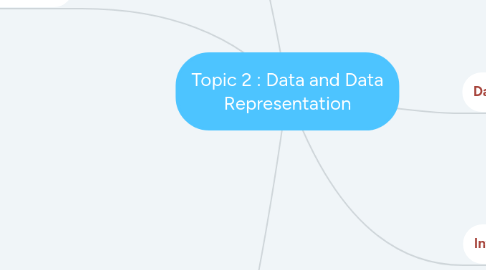
1. Processing
1.1. - Data encoding
1.2. - Data storage & Compression
1.3. - Data Integrity ( Quality of data )
2. Bits , Bytes and Words
2.1. Number Bases
2.1.1. Radix
2.1.1.1. - A single lower case letter appended to the end of each number to identify its type
2.1.2. Base
2.1.2.1. - Different symbols required to represent any given numbers
2.2. Binary System
2.2.1. - Early computers design was decimal
2.2.2. - ENIAC (computer)
2.2.3. - Stores both instruction & data as individual electronics
2.2.4. - Base number is 2
2.2.5. - Instruction and data computer stores sequentially
2.3. Octal System
2.3.1. - Base number is 8
2.3.2. - 8 digit numbers available (0,1,2,3,4,5,6,7)
2.4. Decimal System
2.4.1. - Base number is 10
2.4.2. - System based on decimal digits to represents numbers
2.4.3. - Each digit multiple by 10
2.5. Hexadecimal System
2.5.1. - Base 16 numbering system
2.5.2. - Not only to represent integers
2.5.3. - Represent sequence of binary digits
3. ASCII Codes , Unicode
3.1. The Alphaneumeric Representation
3.1.1. - Characters , number digits and punctuation known as alphaneumeric data .
3.1.2. - 3 Alphaneumeric codes common use in
3.1.2.1. * Unicode
3.1.2.2. * ASCII (American Standard Code for Information Interchange)
3.1.2.3. * EBCDIC (Extended Binary Coded Decimal Interchange Code)
3.2. ASCII
3.2.1. - Standard 7-bit code
3.2.2. - To provide a standard to code various symbols (visible / invisible symbols)
3.2.3. - Each binary value between 0 & 127 represents specific characters
3.2.4. - Assigning standard numeric values to letters , numbers , punctuation marks and control codes
3.3. Unicode
3.3.1. - Worldwide character-encoding standard
3.3.2. - Enable single unique character set that capable of supporting all characters from all scripts , symbols , commonly utilized for computing processing the globe .
3.3.3. - 16-bit standard
3.3.4. - Superset of ASCII
3.4. Usage of ASCII
3.4.1. - Encode text for creation of passwords
3.4.2. - Encode characters to display on all webpages
3.4.3. - Encode characters used in email settings
3.4.4. - Modify characters used in documents
3.5. EBCDIC
3.5.1. - Characters code from different from ASCII
3.5.2. - Developed by IBM
